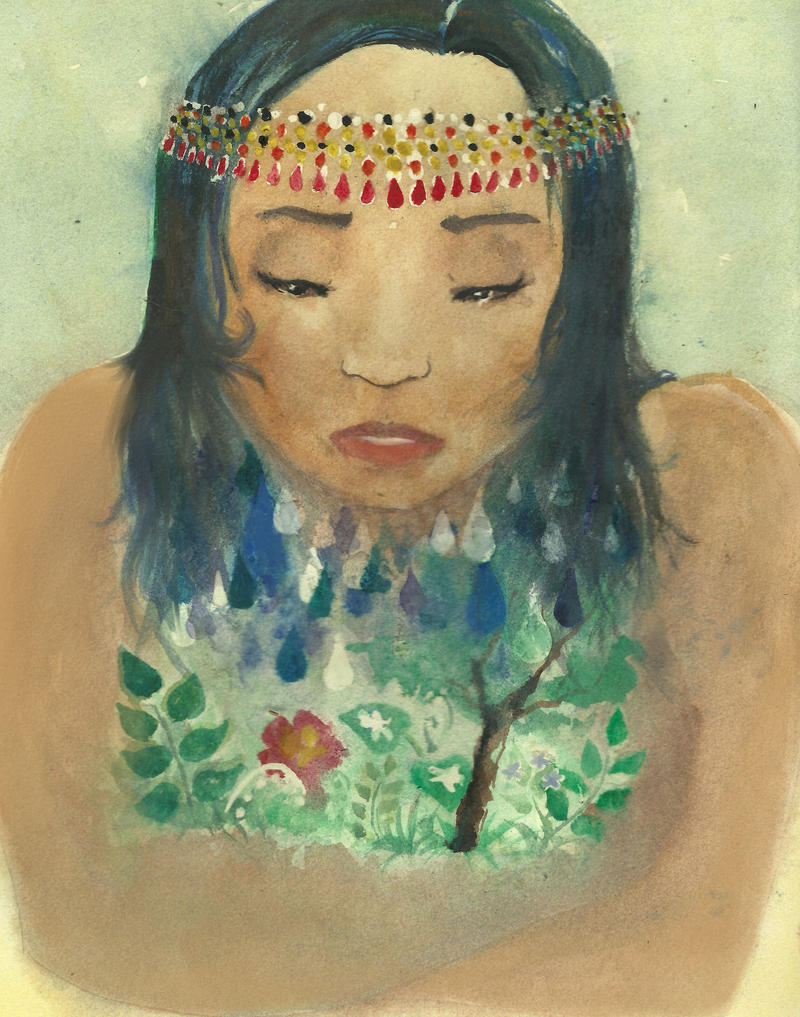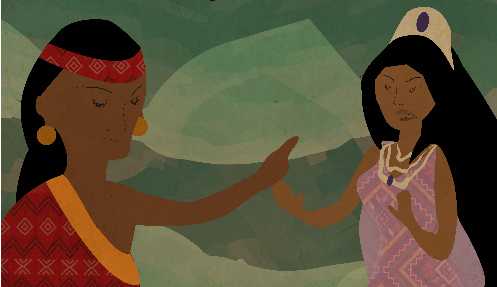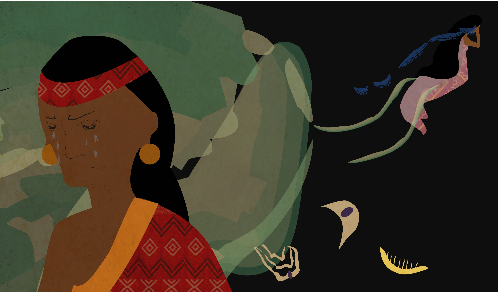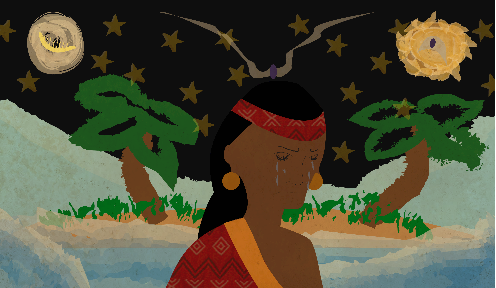Who the heck are Tungkung Langit and Alunsina?
I received an interesting question from someone the other day. “Good day! I’m a bit confused, the first generation Visayan gods to third generation gods are from the Visayan Creation Stories – which are Kaptan, Maguayan, Lihangin, Lidagat etc. Then there’s Tungkung Langit and Alunsina, so, there are other Visayan Creation Myths?”
The answer is yes! As with everything in Philippine Mythology, the explanation is rooted in a confusing and complex history. Much of what we know today about ancient Visayan Beliefs is due to Spanish documentation. Miguel de Loarca was one of the first Spanish conquistadors to arrive in the Philippines and was the author of Relacion de las Yslas Filipinas. This is one of the main texts used to piece together pre-Spanish Beliefs. The familiar Visayan Creation story with Kaptan and Maguayan was documented by John Maurice Miller in Philippine Folklore Stories (Boston: Ginn and Company, 1904). It wasn’t until 1955, when Filipino anthropologist F. Landa Jocano became interested in native folklore and travelled the hinterlands of his home island of Panay (collecting folk songs, stories, and riddles) that we learned of the creation story involving Tungkung Langit and Alunsina.

The tragedy in this is that there are probably many societies throughout the Visayas that had their own variation of the creation story that has simply been lost to time – or perhaps waiting to be discovered. Many blame the Spanish for the disappearance of ancient beliefs, but then must also use the Spanish documentation to understand it. Not unlike the Aztec and Inca civilizations – that once flourished in Central and South America – we know that Spanish explorers precipitated their destruction. However, it is also through the Spanish documentation that those belief systems have been pieced together to create a cultural pride and ethnic identity.
The beauty of the Tungkung Langit and Alunsina creation story is that it was documented by a Filipino anthropologist wanting to better understand his culture. More so that the story, along with the Hinilawod Epic, survived Spanish colonization and Catholicism, yet shows ties to other cultural influences. This is important because it gives us an idea of how pre-Spanish Animism, Indianized beliefs, and Islam spread through the relatively peaceful manner of migration and trade. Sure there was war, but it was never about imposing beliefs.
Tungkung Langit and Alunsina?
TUNGKUNG LANNGIT: A popular deity of the Suludnon people of Panay. He is their version of the ‘creator’ who made the world out of primordial chaos. In other Visayan pantheons, Tungkung Langit was a lesser deity and brother of Panlinugon, god of earthquakes.
ALUNSINA: A prominent goddess in the Suludnon people’s Pantheon of Gods. Alunsina, also called “ Laon-Sina” is considered to be the ‘virgin goddess’ of the eastern skies and the wife of Tungkung Langit (“Pillar of Heaven”). In a Panay version of the Creation Myth Alunsina’s name has been translated as the “Unmarried One”, “ The One from Foreign skies” and “ One who is Foreign”. Alunsina also appears in the Hinilawod Epic.

Tungkung Langit and Alunsina Creation Myth
In the beginning everything was shapeless and formless. The earth, the sky, the sea, and the air were almost mixed up. In a word, there was only confusion. Then from the depth of this formless void there appeared the god Tungkung Langit and the goddess Alunsina.
It was not known just where these two deities came from but it is related by old Bisayan folk that Tungkung Langit fell in love with Alunsina. After he had courted her for many years, they married and made their home in the highest part of heaven. There the water was always warm and the breeze was forever cool. In this place order and regularity began.
Tungkung Langit was a loving, hard-working god. He wanted to impose order over the confused world. He decided to arrange the world so that the heavenly bodies would move regularly. On the other hand, Alunsina was a lazy, jealous, selfish goddess. She sat at the window all day doing nothing.

Sometimes she would leave her home, sit down by a pool near the door, and comb her long, jet-black hair all day long. One day Tungkung Langit told his wife that he would be away for some time. He said he must make time go on smoothly and arrange everything in the world.
When he was gone, Alunsina set the breeze to spy on Tungkung Langit. Tungkung Langit found this out and he became very angry. After he returned home, he told her that it was ungodly of her to be jealous since there were no other gods in the world except the two of them.
Alunsina resented this reproach, and they quarreled. In his anger, Tungkung Langit drove his wife away. No one knew where she went. Several days later, Tungkung Langit felt very lonely. He realized that he should not have lost his temper. But it was too late.

Once vibrant with Alunsina’s sweet voice, his home became cold and desolate. In the morning when he woke up, he would find himself alone. In the afternoon when he came home, he would feel the same loneliness creeping deep in his heart because there was no one to meet him at the doorstep or soothe the aching muscles of his arms.
For months, Tungkung Langit was in utter desolation. He could not find Alunsina, try hard as he would. And so, in desperation, he decided to do something in order to forget his sorrows. For months and months he thought, but his mind seemed pointless; his heart weary and sick. He needed something to ease his lonely world.
One day, while he was sailing across the regions of the clouds, a thought came to him. He would make the sea and the earth, and the earth and the sea suddenly appeared. However, the sombre sight of the lonely sea and the barren land irritated him. So he came down to earth and planted the ground with trees and flowers.
Then he took his wife’s treasured jewels and scattered them in the sky, hoping that when Alunsina would see them she might be induced to return home. The goddess’s necklace became the stars, her comb the moon and her crown the sun. However, despite Tungkung Langit’s efforts, Alunsina did not come back.

Until now, some elders of Panay say Tungkung Langit lives alone in his palace in the skies. Sometimes, he would cry out his pent-up emotion and his tears would fall down upon the earth. When it thunders hard, it is Tungkung Langit sobbing, calling for his beloved Alunsina to come back, entreating her so hard that his voice reverberates across the fields and the countryside.
Source: Alunsina with Tungkung Langit adapted by F. Landa Jocano in Outline of Philippine Mythology
ALSO READ: VISAYAN Origin Myth: Creation of the Sun and Moon
Jordan Clark is a Canadian born descendant of Scottish immigrants living on the homelands of the Lekwungen speaking peoples. His interest in Philippine myth and folklore began in 2004. Finding it difficult to track down resources on the topic, he founded The Aswang Project in 2006. Shortly after, he embarked on a 5 year journey, along with producing partner Cheryl Anne del Rosario, to make the 2011 feature length documentary THE ASWANG PHENOMENON – an exploration of the aswang myth and its effects on Philippine society. In 2015 he directed “The Creatures of Philippine Mythology” web-series, which features 3 folkloric beings from the Philippines – the TIKBALANG, KAPRE and BAKUNAWA. Episodes are available to watch on YouTube. Jordan recently oversaw the editing for the English language release of Ferdinand Blumentritt’s DICCIONARIO MITOLÓGICO DE FILIPINAS (Dictionary of Philippine Mythology) and is working on two more releases with fellow creators scheduled for release later this year. When his nose isn’t in a book, he spends time with his amazing Filipina wife of 20 years and their smart and wonderful teenaged daughter.


